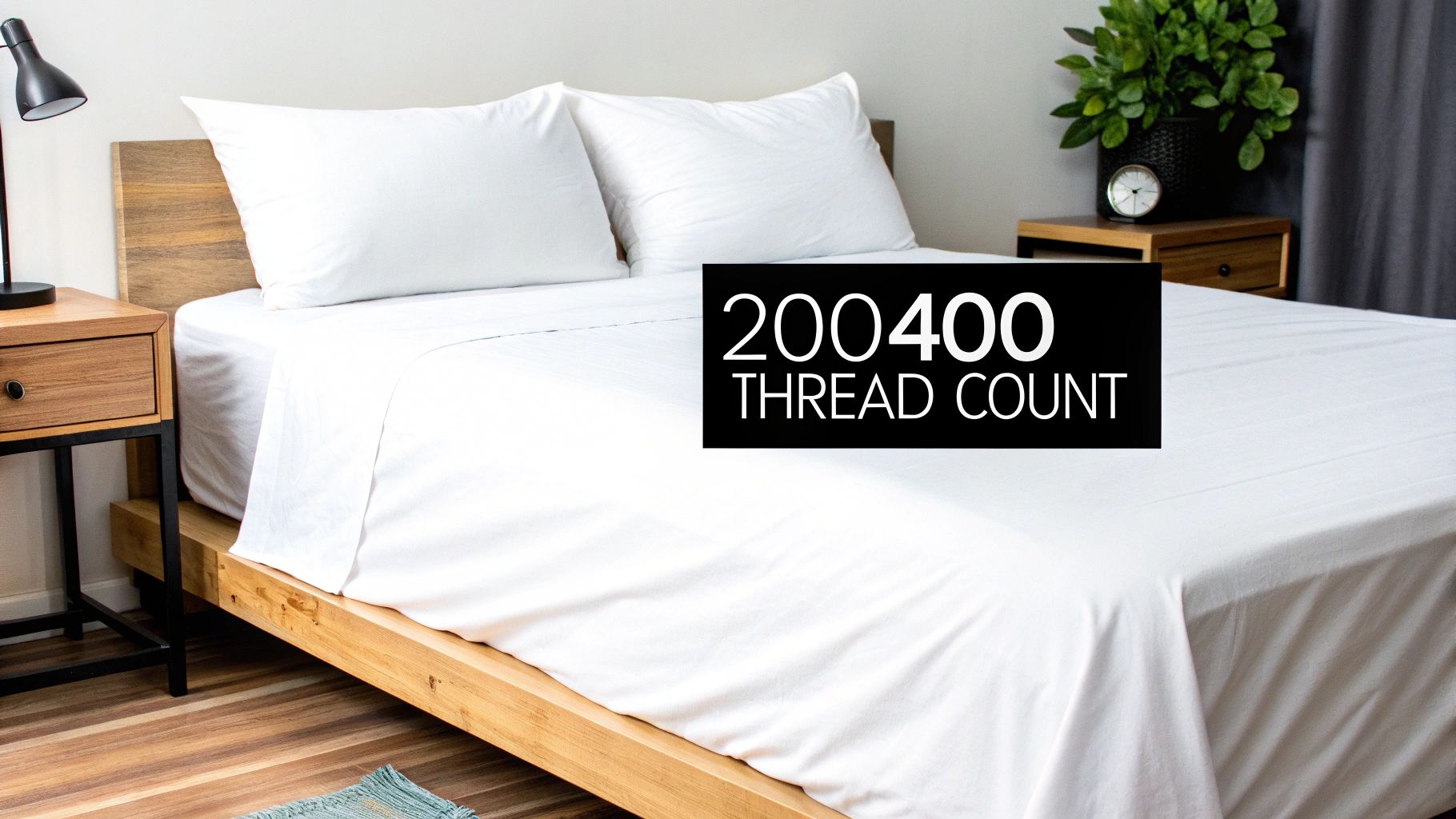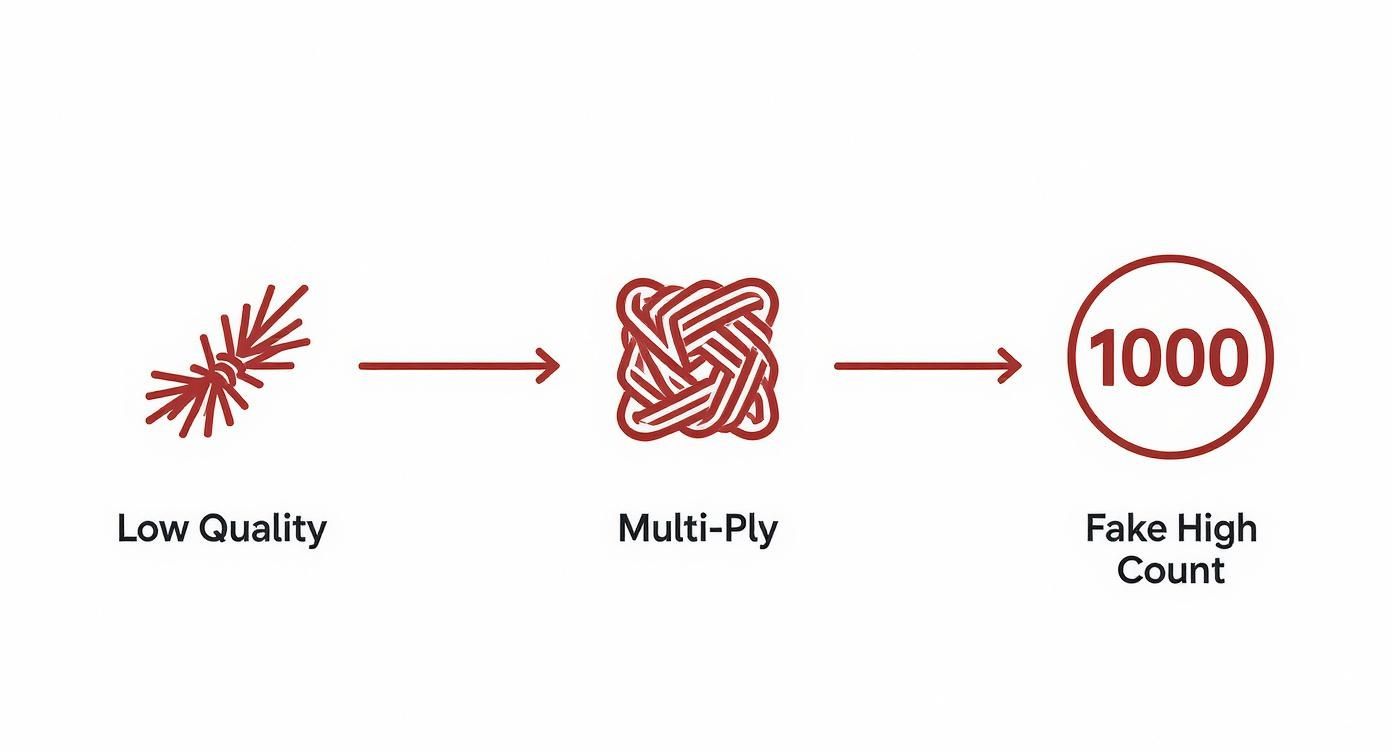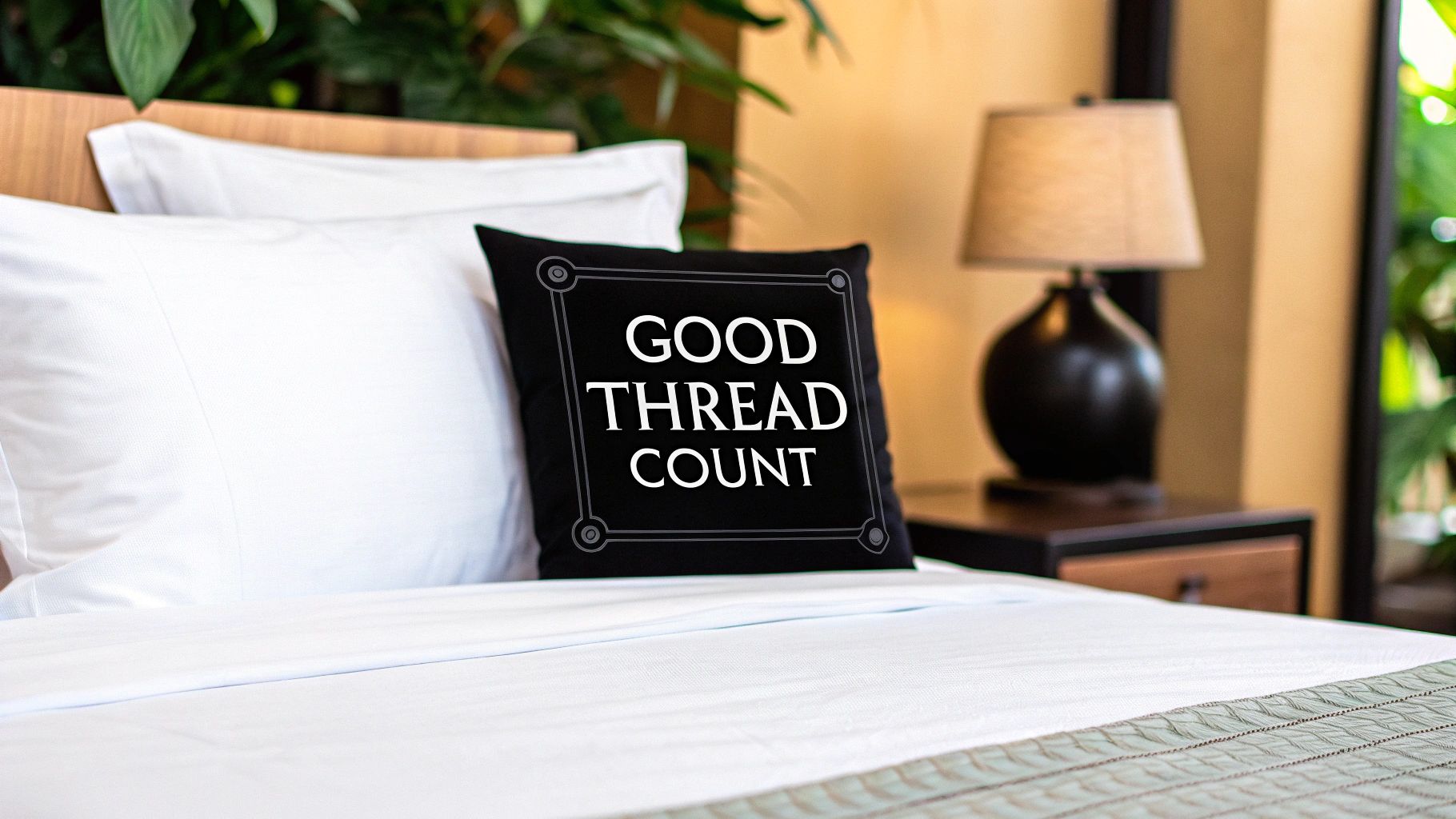For most of us in the UK, the magic number for a great night's sleep lies somewhere between a 200 and 400 thread count. This is the genuine sweet spot where softness, durability, and breathability come together perfectly. Think of it as the ideal recipe for bedding that feels just right.
Why a 200 to 400 Thread Count Is the Gold Standard

When you are shopping for new sheets, 'thread count' gets mentioned a lot. But what does it really mean for your comfort? Instead of being dazzled by marketing hype and sky high numbers, focusing on the 200 to 400 range is the simplest way to find real quality without paying for something you do not need.
This range hits the mark because it strikes an ideal balance between the density of the weave and the quality of the yarn itself. If you dip below 200, the fabric can start to feel a bit thin, almost coarse. On the other hand, going much beyond 400 does not automatically mean better sheets. In fact, some of those ultra high counts can feel surprisingly stiff and actually trap heat, which is the last thing you want on a warm night.
What You Really Get With the Right Thread Count
Opting for sheets in this ideal range brings practical benefits you will notice from the very first night. It is less about the number and more about the experience.
- Lasting Softness: The fabric feels lovely and smooth against your skin, and the best part is that it often gets even softer with every wash.
- Superb Breathability: A weave in this range is tight enough for a premium feel but still lets air circulate, helping you stay comfortable all night long.
- Everyday Durability: These sheets are built to last. They can handle daily use and frequent washing, making them a smart investment for any household.
Ultimately, thread count is a crucial piece of the puzzle, but it does not tell the whole story. To truly find your perfect match, it is worth understanding the best fabric for bed sheets and how different materials change the feel completely.
Let's Unravel the Mystery of Thread Count

So, what exactly is thread count? It is much simpler than it sounds. Picture a single square inch of fabric. The thread count is just the total number of threads running lengthwise (the warp) and widthwise (the weft) packed into that tiny square.
For a long time, the industry pushed the idea that a higher number automatically meant better sheets. While thread count is certainly part of the quality equation, it is far from the whole story. Getting to grips with this basic measurement is the first step to seeing past the hype and finding bedding you will truly adore.
An Easy Way to Think About Thread Count
Imagine thread count as lanes on a motorway. A sheet with a 200 thread count is like a spacious dual carriageway. It allows for plenty of airflow, keeping things light and breathable. Bump it up to a 400 thread count, and you have got something more like a four lane motorway. It feels denser and more substantial, yet everything still flows smoothly.
This is precisely why experts so often point to the 200 to 400 range as the sweet spot. It strikes that perfect balance between a luxuriously smooth feel and a refreshingly cool night's sleep.
The real secret to beautiful bedding is not just about cramming in more threads. It is about the quality of the threads themselves and the artistry of the weave.
How those threads are woven together makes a world of difference to how the fabric feels against your skin. A weave designed to be crisp and cool is made very differently from one intended to feel silky and smooth. For instance, if you are drawn to a buttery soft feel with a subtle lustre, you can explore how that is achieved in our guide on what is sateen. Understanding the weave is key to matching the texture to your personal preference.
Why High Thread Counts Can Be Misleading
Have you ever seen a set of sheets with a 1,000 thread count and thought they must be the height of luxury? It is an easy assumption to make, but that impressive number can often be more of a marketing gimmick than a true sign of quality.
So, how do they get to such a high number? Some manufacturers play a clever numbers game. They use thinner, lower quality fibres and twist several of them together into a single thread. This is what is known as using multi ply yarns.
The catch is, they count each of those tiny, twisted strands individually. This artificially inflates the thread count and misleads you into thinking you are buying something more premium than it actually is.
The Problem with Multi Ply Yarns
This means a sheet advertised with an 800 thread count might really be a lower quality 400 thread count sheet in disguise. Instead of feeling soft and luxurious, these multi ply yarns create a fabric that feels surprisingly dense, heavy, and far less breathable. You end up with stiff sheets that trap heat, which is the exact opposite of what you want for a comfortable night's sleep.
The real measure of quality is not about chasing the highest number. It is about the finesse of the yarn and whether single or multi ply threads are used. These factors play a far more critical role in comfort than just thread density.
Many of us in the UK have been conditioned to see a big number and think "softness," but it pays to look beyond the label. In fact, regulatory bodies like the UK's Advertising Standards Authority are wary of marketing that relies on thread count alone. You can find more detail on this in Richard Haworth's piece on thread count explained.
That is why focusing on single ply sheets made from high quality cotton is a much smarter move. It ensures the number on the packaging is an honest reflection of quality. Of course, cotton is not the only option. If you are curious about other materials, you can explore them in our guide on what is microfiber bedding.
What Matters More Than a High Number
Now that we have seen how easily thread count can be manipulated, let's talk about what really makes for incredible bedding. Forget getting fixated on one big number. A far better way to judge quality is to look at the three pillars of a great fabric, which are the fibre, the weave, and the ply.
When these three elements work together, you get sheets that feel soft, breathe beautifully, and last for years. It is about understanding the complete picture of quality, not just one part of it.
The Importance of High Quality Fibre
If there is one thing that defines how your sheets feel against your skin, it is the quality of the fibre they are made from. Think of it like cooking, where the best ingredients will always produce a better dish. In the world of cotton, that means looking for long staple fibres, the kind you find in premium varieties like Egyptian or Pima cotton.
These longer, smoother fibres can be spun into incredibly fine, yet strong, yarns. This is what gives you sheets that are:
- Noticeably softer and far less likely to pill or feel coarse over time.
- More durable and resistant to tearing, holding up wash after wash.
- Incredibly breathable, allowing air to circulate properly for a much more comfortable sleep.
This infographic shows exactly how manufacturers can use lower quality fibres to create a misleadingly high thread count.

As you can see, the process often starts with weaker, shorter fibres, which are then twisted together just to inflate that final number on the packaging.
Weave and Ply: The Finishing Touches
After the fibre itself, the weave is what gives the sheets their unique texture and feel. A crisp percale weave feels light and cool to the touch, making it perfect for warmer nights or for those who tend to sleep hot. A sateen weave, on the other hand, creates a silkier, smoother surface with a subtle sheen, offering a more draping and indulgent feel. Which one is right for you really just comes down to personal preference.
Finally, always check for single ply construction. This is your guarantee of honesty. It tells you the thread count is based on individual, high quality threads, not weaker ones twisted together to artificially boost the count. Thankfully, UK Trading Standards and advertising regulations help prevent such deceptive claims, pushing brands to be more transparent. By prioritising these three factors, fibre, weave, and ply, you can confidently choose genuinely luxurious bed linens that truly deliver on their promise of comfort.
How to Choose Your Perfect Sheets
With so many options out there, walking down the bedding aisle can feel a little overwhelming. But now that you understand what actually goes into making quality sheets, you can confidently look past the flashy marketing and focus on what really matters.
Think of this as your simple checklist for finding a set you will love sleeping on for years to come. By focusing on a few key details, you can easily pick out sheets that deliver genuine, lasting comfort.
Your Simple Checklist for Better Bedding
When you are ready to buy, keep an eye out for these signs of true quality, both on the packaging and in the feel of the fabric itself.
-
Look for 100% Long Staple Cotton: Words like Egyptian or Pima are your best friends here. This tells you the cotton fibres are longer, which translates directly into a softer and much more durable fabric. You can learn more about the benefits of quality materials by exploring organic cotton bed sheets.
-
Check for Single Ply Construction: This is a clear indicator of honest manufacturing. It confirms the thread count on the label is genuine and has not been artificially inflated with weaker, multi ply yarns.
-
Feel the Fabric: Do not be shy about opening the package if the store allows it. A high quality sheet should feel smooth and substantial in your hands, not rough or flimsy.
The goal is to find bedding that not only looks beautiful but feels incredible night after night. By prioritising fibre quality and honest construction over just a number, you are investing in better sleep.
And if you are looking to upgrade your entire sleep setup, you might find a broader perspective in this complete guide to bedding, mattress protectors, and comforters.
Common Questions About Bed Sheets, Answered
Even with all the facts laid out, a few questions always seem to come up when you are on the hunt for new bedding. Let's tackle some of the most common queries to help you feel completely confident in your final choice.
Is a 200 Thread Count Good for Cotton Sheets?
Absolutely. In fact, a 200 thread count is a fantastic benchmark for quality, especially when you find it in a percale weave. Sheets like these are famous for their wonderfully crisp, light, and breathable feel, making them a dream if you tend to sleep a bit warm.
They are also impressively durable and hold up brilliantly to regular washing. The best part is that high quality percale actually gets softer and more inviting the more you use it.
Are 1000 Thread Count Sheets Worth the Money?
Honestly, probably not. An extremely high thread count is usually just a clever marketing tactic, not a true indicator of quality. Inflated numbers are often created by twisting multiple, thinner yarns together. This can ironically lead to sheets that feel heavy, dense, and not nearly as soft as you would expect.
These overly dense sheets can also trap heat, making for a less comfortable night's sleep. A beautifully crafted 400 thread count sheet made from high quality, single ply cotton will almost always feel more luxurious, breathe better, and last much longer than a sheet with a gimmicky high number.
What Is Better: Percale or Sateen Weave?
This one is all about personal preference, as it really comes down to the texture you love to sleep on. Both are excellent choices, but they offer very different experiences.
- Choose percale if you adore that crisp, cool feeling, much like a freshly pressed shirt. It has a classic matte finish and is incredibly breathable.
- Choose sateen if you are looking for a silky, smooth feel with a subtle lustre that drapes beautifully. It feels exceptionally soft against the skin and is a touch warmer.
Ultimately, the best weave is simply the one that makes you look forward to climbing into bed every single night.
Ready to experience the perfect blend of comfort and style? Explore the beautiful bedding collections at Morgan and Reid and find the ideal sheets to complete your cosy sanctuary. https://www.morganandreid.com



Share:
Your Guide to Extra Deep Brushed Cotton Fitted Sheets
A Guide to Double Duvet Size in the UK